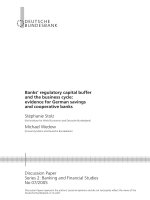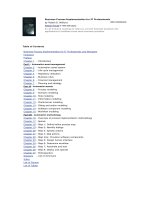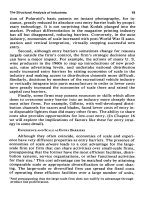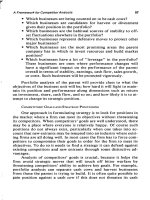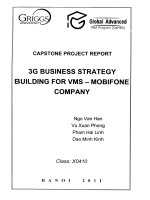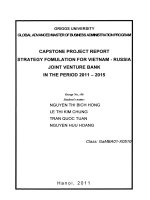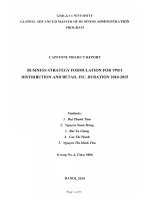Luận văn BUSINESS STRATEGY FORMULATION FOR VNF1 DISTRIBUTION AND RETAIL JSC
Bạn đang xem bản rút gọn của tài liệu. Xem và tải ngay bản đầy đủ của tài liệu tại đây (1.41 MB, 77 trang )
THESIS MBA
BUSINESS STRATEGY FORMULATION FOR VNF1
DISTRIBUTION AND RETAIL JSC, DURATION 2015-2020
Page 1 of 77
TITLE: BUSINESS STRATEGY FORMULATION FOR VNF1
DISTRIBUTION AND RETAIL JSC, DURATION 2015-2020
TABLE OF CONTENTS
INTRODUCTION.................................................................................................................5
Overview of VNF1 JSC.....................................................................................................6
Necessity of the Project ....................................................................................................6
Objectives of the Project and Its Contribution to the Development of VNF1 JSC...........7
Methodology......................................................................................................................7
Structure of the Capstone Project......................................................................................7
CHAPTER 1: THEORETICAL FRAMEWORK.................................................................9
1.1. Strategy and Business Strategy Management.............................................................9
1.1.1 Strategy ................................................................................................................9
1.1.2 Business strategy management.............................................................................9
1.2. Process of strategy plan formulation........................................................................10
1.2.1 Mission and core objectives...............................................................................11
1.2.2 Selection and formulation of strategic objectives..............................................12
1.2.3. Analysis of external environment......................................................................12
1.2.3.1 Macro environment.....................................................................................12
1.2.3.2 Micro level environment (sectoral)............................................................16
1.2.4. Analysis of internal environment......................................................................19
1.2.4.1 Analysis of area of operation -Value Chain................................................19
1.2.4.2. Core ability.................................................................................................20
1.2.5. Selection of strategy..........................................................................................21
1.2.5.1 Analysis Tools.............................................................................................21
A. SWOT analysis...................................................................................................21
B. EFE – External Factor Evaluation Matrix..........................................................22
C. IFE - Internal Factor Evaluation Matrix.............................................................22
1.2.5.2. Selection of Strategy with QSPM...............................................................23
A. Strategy of cost leadership..................................................................................24
B. Strategy of product differentiation.....................................................................24
C. Strategy of focus point........................................................................................25
D. A combination of strategies...............................................................................25
CHAPTER 2: ANALYSIS OF VNF1 JSC STATUS.........................................................27
2.1. Overview of VNF1 JSC............................................................................................27
2.1.1. Establishment of VNF1 JSC .............................................................................27
2.1.2. Capital................................................................................................................28
2.1.3. Organizational Structure....................................................................................28
2.1.4. Areas and Activities..........................................................................................28
2.1.5. Characteristics of rice trading and the initial role of VNF1 JSC in the market.29
2.2. Analysis of macro environment (PESTLE model)...................................................32
2.2.1 Politics - Legislation ..........................................................................................32
2.2.2. Economics and Environment ............................................................................33
Page 2 of 77
2.2.3. Technology........................................................................................................34
2.2.4. Culture - Society................................................................................................34
2.2.5. Trend of globalization ......................................................................................35
2.2.6. Opportunities/ Threats for VNF1 JSC...............................................................38
2.2.6.1 Opportunities...............................................................................................38
2.2.6.2 Threats.........................................................................................................38
2.3. Sectorial analysis (PORTER model)........................................................................39
2.3.1. Current competitors...........................................................................................39
2.3.2. Substitute products............................................................................................41
2.3.3 Powers of customers...........................................................................................42
2.3.4. Powers of suppliers............................................................................................42
2.3.5. Potential rivals...................................................................................................43
2.4. Analysis of Internal Environment ...........................................................................45
2.4.1. Organizational structure....................................................................................45
2.4.2. Factories, field/ material site.............................................................................46
2.4.3 Business networks..............................................................................................48
2.5. SWOT analysis ........................................................................................................48
2.6. Target customers......................................................................................................52
2.7. Market segment........................................................................................................53
CHAPTER 3: RECOMMENDATIONS ON STRATEGIC PLAN FOR VNF1 JSC,
DURATION 2015-2020......................................................................................................55
3.1. Mandate-Mission and Vision...................................................................................55
3.2. Strategy selection for VNF1 JSC.............................................................................58
3.2.1. External Factors Evaluation (EFE) of VNF1 JSC ............................................58
According to theory, the total EFE point of 2.7 illustrates that VNF1 JSC's reaction
against external factors at average level......................................................................58
3.2.2. Internal Factors Evaluation (IFE) of VNF1 JSC...............................................58
According to theory, the total IFE point of 3.49 (above 2.5) demonstrates that the
VNF1 JSC is strong in internal factors........................................................................59
3.2.3. Quantitative Strategic Planning Matrix (QSPM) and strategy selection for
VNF1 JSC ...................................................................................................................60
3.3. Recommendations on strategies for VNF1 JSC.......................................................61
3.3.1. Marketing mix strategy......................................................................................62
3.1.1.1. Product .......................................................................................................62
3.3.1.2. Promotion...................................................................................................63
3.3.1.3. Place...........................................................................................................65
3.3.1.4. Price............................................................................................................67
3.3.2. HRM strategy....................................................................................................68
3.3.3. Production management strategy......................................................................70
3.3.4. Other functional strategies.................................................................................71
3.4. Milestones in the 5 year strategy implementation....................................................72
3.5. Other Recommendations .........................................................................................73
3.5.1. At the macro level.............................................................................................73
3.5.2. At the micro level..............................................................................................73
CONCLUSION...................................................................................................................73
REFERENCES....................................................................................................................75
ANNEX...............................................................................................................................76
List of Abbreviation
Page 3 of 77
VNF1 Corporation or Corporation:
VNF1 JSC or VNF1, or Company:
HACCP:
TCVN:
Vietnam Northern Food Corporation;
VNF1 Distribution and Retail JSC
International food hygiene and safety standards
Vietnam food hygiene and safety standards
List of Figures
Figure 1.1. Process of strategy formulation.........................................................................11
Figure 1.2. Levels of external environment.........................................................................13
Figure 1.3. The five forces of competition (Porter Model).................................................17
Figure 1.4. Porter’s model of Value Chain..........................................................................20
Figure 2.5. Fluctuations in the rice market in the past 3 decades ($/ton)............................30
Figure 2.6. Changes in domestic rice market in 2008 (Source: VNF1 report, 2008)..........30
Figure 2.7. Real GDP Growth Rate Across Southeast Asia (Source: Fearless Forecasts,
CBRE, 2010).......................................................................................................................33
Figure 2.8. Rice as a percentage of total caloric intake by region (2000)...........................35
Figure 2.9. Modern shopping channel development (Source: VNEconomy, 2008)...........36
Figure 2.10. Value line of VNF1 JSC and competitors (50kg packed rice)........................44
Figure 2.11. VNF1 JSC material areas map (Source: VNF1 Report, 2008).......................47
Figure 3.12. Exploitation of Philip Kotler 5- product levels ..............................................63
Figure 3.13. Procedures of rice supply (Source: VNF1 Market survey, 2008)...................66
Figure 3.14. VNF1 JSC distribution system........................................................................67
Figure 3.15. HRM clients....................................................................................................69
Figure 3.16. Integral connections of performance appraisal...............................................69
List of Tables
Table 2.1. Comparison of some competitors in high-quality rice market (Source: Market
survey, VNF1, 2008)...........................................................................................................40
Table 2.2. Analysis of VNF1 JSC’s target customers 2009/2010.......................................52
Table 3.3. Market objective of VNF1 JSC, duration 2015-2020 (Source: VNF1 report,
2008)....................................................................................................................................57
Table 3.4. Target market share (Source: VNF1 report, 2008).............................................57
Table 3.5. QSPM for VNF1 JSC.........................................................................................60
Table 3.6. Milestones in the 5 year strategy implementation..............................................72
Page 4 of 77
INTRODUCTION
Rice is life. Rice is the grain that has shaped the cultures, diets, and
economies of Vietnam. Rice is the stuff throughout all the subjects of our group in
the Griggs MBA Program. This research is the integral link of all these study and
efforts of group members, the continuous assistance from lecturers, encouragement
from the Company management and the emotional support from family members.
Project title: BUSINESS STRATEGY FORMULATION FOR VNF1
DISTRIBUTION AND RETAIL JSC, DURATION 2010-2015
1.
Page 5 of 77
2.
Overview of VNF1 JSC
VNF1 Distribution and Retail Joint Stock Company is a member of the
VNF1 Northern Food Corporation. The Company was established and came into
operation on the 1st of July, 2008 according to the direction of the Prime Minister
on the strategic plan for the Corporation in production and trading in the northern
areas, from Nghe An Province with the aim to maintain food security in the
northern market.
Target of VNF1 JSC establishment is to improve the weakness in the
industry of food and rice trading through the development of a professional
business administration model, with the close and systematic collaboration among
different process of production, trading and distribution. The Corporation will
multiply the success of the model in the entire Corporation, with the aim of
continuous improvement to catch up with the integration trend of the market.
The Corporation now has 27 independent member companies, of which 5
are partnerships and 3 are joint ventures with foreigners. All are food trading
companies with decades of experience as buying agents for Corporation’s export
purposes.
Necessity of the Project
VNF1 JSC is quite a young company, having no official development
strategy. This research project is of great importance for the Company in particular
and for the Corporation in general towards the target of building up a modern
business model in the food trading sector.
In a greater context of the Corporation, the development of VNF1 JSC will
assist the Corporation to start modern business model, to generate a quite new
approach with customers, from which to assist the Corporation to reach its
sustainable target of building up a modern, specialized, intensive and extensive
Page 6 of 77
distribution system, gradually mastering the market of rice, leading the market of a
strategic commodity to advance in the right and healthy direction.
Objectives of the Project and Its Contribution to the Development of VNF1
JSC
VNF1 JSC is participating in a highly competitive market with lots of
challenges. In this market, there is not yet a real successful player; a competitor is
not a company as a single player, but is a full public business orchestra. Though
without a leader, the “orchestra” is performing perfectly, generating a huge impact
by the strength of a true open market.
As a matter of fact, members of the Group 6, Class M06, being officials in
and out of the industry, expect to use the modern knowledge of business
administration achieved in the Griggs MBA Grogram to response to the urgent
need of the Company of working out a professional action plan, for the short run
first, through which to study issues and identify problems of priority to solve, to
study target customers, to know competitors, to build up strategy of product, price
and so on. This short term strategy will be the launching stage for the Company to
develop efficiently and professionally.
Objective of the Project is to identify 5 year business strategic plan for
VNF1 JSC to become the leading high quality rice producer and trader in Vietnam
Methodology
The group uses problem analysis, SWOT analysis based on secondary and primary
data, deployment of various economic tools including Porter model, PESTLE
analysis, IFE & EFE, QSPM tools.
Structure of the Capstone Project
o Introduction
o Chapter 1: Theoretical framework for the Project
o Chapter 2: Analysis of the VNF1 JSC Status
Page 7 of 77
o Chapter 3: Recommendation on strategy
o Conclusion
Page 8 of 77
CHAPTER 1: THEORETICAL FRAMEWORK
The terminology of strategy has been mentioned largely in the business
world nowadays. Each enterprise has its own method to approach and to build up
its business strategy. In this Chapter, we would like to introduce a popular
methodology to design and to select business strategy, its process and some
relevant experiences.
1.1. Strategy and Business Strategy Management
1.1.1 Strategy
Strategy is the plan to control and to use the organization’s resources such as
finance and HR to improve and to ensure the essential benefits of the organization.
According to Kenneth Andrews, strategy is what an organization has to do based
on its strengths and weaknesses in the context of certain opportunities and threats.
A good strategy with effective implementation will help managers and
operators at different levels be able to identify objectives, identify orientation for
action, contributing to the success of the enterprise. There might be different
methodology, but the core contents of strategic management include:
• To identify a master action plan with future orientation on basic and long
term business objectives of the enterprise.
• To identify the process for such action, method to implement and resources
allocation to reach such objectives.
• Important policy and measures of the enterprise will be decided to change by
the enterprise’s owner.
1.1.2 Business strategy management
Business strategy of an enterprise is the master action plan with future
orientation in implementing its objectives. Strategy will not identify concretely how
to reach such objectives because it is the functions of other supporting programs
Page 9 of 77
and functional strategies. Business strategy will just create a framework to guide
critical thinking towards business orientation and action.
In the enterprise’s business operation, the existence and success depend firstly
on the rightness of the identified strategy and the implementation process. Business
strategy is essential because:
Firstly, a business strategy will help the enterprise to see clearly objectives
and direction to go in business operation. From that, the enterprise will know how
to organize the business mechanism, what to do to achieve success and milestone
for such achievement.
Secondly, in the fast changing business environment, there are abundant of
profit opportunities together with risks. A strategy will help the enterprise to be
well planned to take the best and the earliest of all opportunities and to reduce to
the least potential risks or have good risk management plan.
Fourthly, in the fierce competitive environment, by all sided analysis of
factors at the macro and micro level, the enterprise will be able to identify
competitors of all kinds, from which to design master solution to intensify
competitiveness of the enterprise.
1.2. Process of strategy plan formulation
Each cycle of strategy formulation will start by a mission and core objectives
statement of the enterprise. Then comes the analysis of internal and external factors and
strategy selection. The process will complete by the design of organizational structure and
relevant monitoring system for the selected strategy implementation.
Page 10 of 77
Figure 1.1. Process of strategy formulation
1.2.1 Mission and core objectives
Mission is a concept to identify objectives of the enterprise, reasons of the
enterprise’s establishment and basic for its existence and development. The nature
of the mission statement is to elaborate a very important matter: what is the
purposes of the enterprise’s business. Scope of the mission statement normally
covers information on products, market, customers, technology and other
philosophy that the enterprise pursuits.
Page 11 of 77
The mission statement will be effective during the whole time of the
enterprise operation if the enterprise does not change or modify it. However, in
each strategic phase, it should state strategic objectives relevant for such phase.
1.2.2 Selection and formulation of strategic objectives
The highest target of the enterprise is a sustainable development in the
market. However, with different conditions and at different phases the priority
might be different. In general, the strategic target will include the below factors:
• Market share
• Profit
• Allocation of resources and risks
• Productivity
• Competitiveness advantage
• HR development, and
• Community social responsibility
1.2.3. Analysis of external environment
The next component of strategy management is to analyze the external
environment. Objective of this is to identify the opportunities and threats, to find
the best solution to operate, to take the best of the good and to reduce to the least
affects of threats.
1.2.3.1 Macro environment
Scope and contents of this include analysis of macro environment according to
the levels of external environment model.
Page 12 of 77
Figure 1.2. Levels of external environment
a. Politics and Legislation (P)
This includes the system of perspectives, policy of the government, legislation
system, especially those concern the business area; political movements in the
country and in the world, factors concerning politics and legislation, including:
• Stability level of politics and diplomatic policy
• Balance in the government policy
• Role and economic development strategy of the Party and the
government
• Trend of interference of the government in to economic and social
activities
• The completion level of legislation system and its implementation
effectiveness in the economy.
As a matter of fact, the legislation system and political stability have deep
affects. If the legislation system is not sufficient, not transparent and not feasible,
there will be negative impacts on the people’s lives.
b. Economy (E)
This has direct and strong impacts on business operation. Economic
factors can change the ability to create value and income of the enterprise. Four
important factors of macro economic environment are:
• Economic growth rate
Page 13 of 77
• Interest rate
• Exchange rate
• Inflation rate
For those in distribution business, economic growth can lead to increase
and booming in customers’ expenditure which is quite favorable for businesses. On
the contrary, if the economy is declining, price competition will come to a
saturation point.
Interest rate will be another important factor. High rate will encourage
people with extra money to save rather than to expense. Those lack of money will
avoid lending for purchases.
Exchange rate identify value balance between different currencies.
Changes in exchange rates will have direct impact on the competitiveness globally.
For those doing business in distribution, measurement of changes in
exchange rate to make decision on sources of suppliers will be very important for
business effectiveness.
Inflation rate is the factor that reduce the stability of the economy, less
growth and more interest rate. In high inflation, investment will be risky. Forecast
for economic variances will be uncertain.
c. Culture - Society (S)
Cultural and social factors leave impacts on lives and behaviors of human
being, influencing demand structure, buying behaviors and consumption trend, with
special attention to commercial enterprises in the below aspects:
• Population size and trend
• Age structure
• Population allocation and moving trend
• Diversity of mankind
• Income structure
• Living styles, consumption habits
Page 14 of 77
Enterprise will pay attention to the changes of the above factors so as to
have early awareness of trends and changes in consumption behaviors, adopting
relevant methods in doing business, shifting to relevant products.
d. Technology (T)
Technological factors decide the coming into being of new products,
establishing method of doing business, and method of meeting demand, influencing
the competitiveness ability and effectiveness of the business. Internet is a typical
example for technological impact. It is abolishing and restructuring sectors
dramatically. It is threat to the industry of post, newspapers but the opportunity for
online retailers.
Obviously, with internet, wireless technology, bio-technology and a series
of other inventories are reforming economic sectors, bringing about chances and
challenges to businesses globally.
Practically speaking, successful enterprises are those who are quick at
adopting advanced technological achievement for their production and business
operation in relevance with their conditions.
e. Population and natural environment
Population has close conjunction with development. Important aspects of
this are
• Size: total population, labor force
• Structure, development trend, age structure, gender, geographical and
religion
• Quality of education, civil level, abilities
• Professions, income
• Territorial allocation
Natural environment including geographical, climate, natural landscape,
soil, sea and water, natural resources, forest resources and so on. These not only
play important role in quality of lives but also the binding condition in identifying
business strategy.
f.
International environment
Page 15 of 77
Globalization and integration is the world’s trend. Economic relations
among nations, regions have great impacts on different areas of social lives that all
enterprises and sectors have to take into considerations. The dramatic development
of science and technology, rapid advance in informatics technology have promoted
connection of global commercial enterprises into one network. These have direct
impacts on business operation and firstly on strategic management. Particularly,
they are:
• International politics
• International economy
• International legislation and practices
• International technology
• International culture
As a matter of facts, the analysis of macro level environment is to forecast
the changes, trends in external factors. With the focus on the future, these analysis
allow identification of opportunities and threat, from which to be able to prepare
solution to advance with production and business operation.
1.2.3.2 Micro level environment (sectoral)
A sector is a group of companies supplying products or services what can
be close substitute for each other. That means these products and services to meet
demands are basically the same.
Michael E. Porter, Professor of Harvard business school has invented the
model that help to identified these factors. According to Porter, there are 5 major
factors of sectoral competition like below (Michael E. Porter, Competitive Strategy,
New York: Freepress, 1980):
Page 16 of 77
Figure 1.3. The five forces of competition (Porter Model)
The stronger these factors are, the better they can limit the ability of the
current enterprise in raising value and getting better profit. Such strength can
change over time when sectoral conditions change.
Administrators are to identify opportunities and threats that the changes of
these 5 factors can bring, then to build up relevant strategy. The 5 factors are:
a. Potential competitors
These include companies that are not in the sectoral competition but they
are capable to do that if they want. For instance the post and telecommunication
can compete with banks in money transfer or payment. The identification of
potential competitors are important, showing potential invaders into the market
share. So efforts to be more effective and more dynamic are needed.
b. Current sectoral competitors
This is the level of competition among companies within a sector. Because
enterprises in one sector are dependent on each other, action of one enterprise
usually draw actions of others in response. If such competition is weak, enterprises
will have opportunities to raise price and get more profit. But if the competition is
strong, there might be war in pricing. This kind of competition is likely to include
sectoral competition structure, sectoral situation and exit restriction.
c. Power of buyers
Page 17 of 77
Bargaining power of buyers are the third force. These might be the end
users, or suppliers, traders, retailers. Buyers can be seen as competition threat when
they are able to force enterprise to reduce price or to demand better quality and
services. On the contrary, when buyers are weak, enterprise will have chance to
raise price and to get more money. These are relative power of buyers. According
to Porter, buyers have the most powers in below cases:
• When the supplying sector is made of a lot of small enterprises and there is a
few buyers but with large quantity. Buyers can influence suppliers.
• When buyers are buying in bulk amount. They will then use the advantage
of large amount to request unfair discount.
• When the sector depends on buyers because a large percentage of orders are
made by them.
• When buyers can shift to cheaper supplier.
• When buyers can threat suppliers when they have vertical integration
connection. This is their tool to reduce price.
d.
Power of suppliers
This is the bargaining power of suppliers. They can be threat if they tend
to increase price in supplying or reduce quality that harm quality of final products
and services, reducing profitability of enterprises. On the contrary, if suppliers are
weak, enterprise has the opportunity to request discount and better quality. Just like
in case of buyers, this is relative power of suppliers in relationship with an
enterprise.
e.
Threats of substitute products
Products with typical features will dominate. This threat requires
enterprise to analyze and to have close watch on scientific and technological
advances, with direct relation to renovation of technology and products. Moreover,
changes in demands will be an important factor in creating threats.
The study of 5 forces in M. Porter model helps enterprise to have a deep
understanding on the market, to identify attractiveness of the sector in term of
potential profit comparing with investment. A sector will be attractive if:
• Just a few entrance restriction
Page 18 of 77
• Firm positions of suppliers and buyers
• Threat of competitive products are huge
• Fierce competition of current competitors
On the contrary, a sector is attractive and profitable potentially if:
• Few entrance restriction
• Weak positions of suppliers and buyers
• Few threat of substitute products
• Medium competition of current competitors
1.2.4. Analysis of internal environment
When the analysis of external environment results in the ability to identify
and decide on what an enterprise can do, the analysis of internal environment is
expected to help the enterprise to identify what they are able to do, based on the
demonstration of strength and weakness that they have to take into considerations
at selecting business strategy.
In fact, it is very difficult to have full assessment of internal factors of an
enterprise because there are too many factors. So, to assess the internal
environment of an enterprise, it is necessary to identify major factors representing
the situation of the enterprise. These factors form the value chain of the enterprise
and its core ability.
1.2.4.1 Analysis of area of operation -Value Chain
The value of an enterprise is measured by the value that buyers are ready
to pay for the enterprise’s products or services. The enterprise will have profit if the
value it creates is higher than the cost to create it. To get a competitive advantage,
functional units must create a value at a cost lower than competitor. In another way,
the functional units must differentiate their products with competitors’, so as to
achieve a higher selling price in the market. In brief, the enterprise has to pursuit
target of low cost leadership or product differentiation.
Page 19 of 77
Strategic
target
Figure 1.4. Porter’s model of Value Chain
1.2.4.2. Core ability
Core ability is the resources and ability that can bring competitive
advantages. It includes operations that the enterprise is able to conduct more
outstandingly than competitors, and operations by which the enterprise creates
unique value in its products and services over a long time. Four criteria for
sustainable competitive advantage are:
• Precious: which helps to exploit the opportunities
• Rare: are those others do not have
• Expensive if counterfeit: due to historical or social reasons or implicit
reasons
• Irreplaceable: no equal competitor
Page 20 of 77
1.2.5. Selection of strategy
1.2.5.1 Analysis Tools
A. SWOT analysis
After assessment and analysis of above factors, in the next step, the
enterprise will select a strategy. To have a suitable development strategy, SWOT
model is popular to have a landscape of strength, weakness, opportunity and threat.
SWOT model is the result of research of Fortune’s top 500 companies
conducted by the Stanford Research Institution during 60s and 70s to find the
reason why a company failed in its plan.
SWOT analysis is one of the 5 steps in formulating business strategy
including: identifying mission, SWOT analysis, identifying strategic goal, forming
strategic objectives and plans and forming strategic supervision mechanism.
Strength: is an operation that the enterprise can do good or a feature that
promote the competitiveness of the enterprise, for instance:
• Valuable ability, know-how
• Valuable asset
• Valuable human resources
• Advantage of low cost due to private production know-how
• Easy access to high class natural resources
• Easy access to distribution network
Weakness: for instance:
• Lack of brand name, know-how, experience or ability
• Bad name in the market
• High cost operation structure
• Less access to natural resources
• Less access to main distribution channel
Opportunity: Analysis of external environment can open new opportunity
for development, for instance
• Good demand
Page 21 of 77
• Coming into being of new technology
• Easy regulations
• Remove of international commercial restriction.
Threat: changes in context or external environment may cause threat to the
enterprise, for instance:
• Taste moves from company’s products to another
• Appearance of substitute
• Tighter international commercial restrictions
B. EFE – External Factor Evaluation Matrix
EFE is a model used to evaluate external factors; it collects and classifies
major chances and threats that the external environment may have on business. By
this, managers can evaluate the enterprise’s exposure to chances and threats and
determine external factors to be chances or threats. Steps to build an EFE:
• Make a list of potential factors of major chances and threats to enterprise
business.
• Classify the factors according to importance in a scale from 0 (not
important) to 1 (very important). The importance is the impact of each factor
on each field of business.
• Determine the weight in range of 1 - 4 for each factor depending on the level
of influence’s chance/ threat on the enterprise.
• Multiply the importance point with its weight to get the final point for each
factor.
• Sum up all component points to get a total point of the matrix.
The higher the total point is, the better the company reacts to chances and
threats.
C. IFE - Internal Factor Evaluation Matrix
Internal factors are very important to the strategy building of an enterprise.
Strategy planners therefore should point out strengths, weaknesses and ability to
Page 22 of 77
react to changes of all internal factors. IEF is often used to help this. IEF matrix is
built as follows:
• Make a list of potential factors of major strengths and weaknesses of the
enterprise.
• Classify the factors according to importance in scale from 0 (not important)
to 1 (very important). The importance is evaluated by the impact of each
factor on the success of business. The total importance point is 1.
• Determine the weight for each factor in scale of 1 -4.
• Multiply the importance point of each factor with its weight to get a point.
• Sum up all component points to get a total point of the matrix.
The higher the total point is, the better the company reacts to challenges.
1.2.5.2. Selection of Strategy with QSPM
Many tools are used to define the best strategy for enterprise business.
Quantitative Strategic Planning Matrix (QSPM) is a modern approach of strategy
administration used to evaluate and select the best strategy. On considering what to
do or which way to take, company managers have a list of strategies alternatives.
The selection process is often subjective and impulsive. The QSPM, therefore,
introduces some approaches to meet technical requirements for this process.
QSPM uses the data collected from the previous steps as inputs to help
define the best strategy among potential ones for the enterprise to follow.
First, have a look into the below example of QSPM which compares
different alternatives. Define the feasibility of a strategy by its major factors and
weight of importance then make decision.
There are 6 steps to develop a QSPM:
(1) List out major external chances/ threats, internal strengths/ weaknesses in the
column of the matrix. These factors are directly retrieved from the EFE and IFE
matrices.
(2) With available data, the determination and selection of strategies alternatives
will be considered. They are shown in the upper row of the table.
Page 23 of 77
(3) Study SWOT or BCG, Hofer matrices and specify replaceable strategies, note
down these in the first row of QSPM. Strategies should be grouped (if applicable).
(4) Calculate the attraction points for each strategy. Only strategies of the same
group can be compared to each other. The points are classified as: 1=not attractive,
2=somewhat attractive, 3=rather attractive, 4=very attractive. The number shows
the relative attractiveness of each strategy compared to others in a group.
(5) Calculate the total attraction point by multiplying the point in step (2) with the
attraction point in step (4).
(6) Sum up all the attraction points to get the total point of a strategy (on
considering all the external and internal factors that may have impact on strategic
decisions). The higher this point is, the more suitable and worthy the strategy
proves.
QSPM shows relative attractiveness of potential strategies and more
importantly provides objective grounds for selecting the best strategy. However, in
order to get exact results from QSPM, business owner should have sharp intuition
to give right points to the attractiveness of each factor. Strategies that business
owner should use separately or in combination are:
A. Strategy of cost leadership
Competing by price is the an overall operation that produce products or
services with characteristics accepted by customers with lowest cost in relative
relation with competitors.
Purpose of the enterprise competing by price is to work better than
competitors by doing anything to produce at lower cost than competitor. This
strategy has two basis advantages: (i) leader by cost can offer lower price than
competitor but keep the same or even higher profit due to his lower cost. (ii) leader
by cost can stay alive when number of competitors in the sector increase, forcing
competitors to compete by price.
B. Strategy of product differentiation
Objective of this strategy is to achieve a competition advantage by creating
products or services which are unique at some important feature. An enterprise
Page 24 of 77
differentiate to meet customers need in the manner that competitors can not do with
the purpose of increasing price (at a significant level than the sectoral average).
Generating income by requesting a higher price of differentiation strategy is higher
than strategy of low cost leadership. Customers are ready to pay for this because
they believe that the differentiation quality is distinguish. And pricing for such
product is made based on what the market welcomes.
C. Strategy of focus point
Strategy of focus and attention. The basic difference with the 2 above
strategies is that this has direct orientation towards a restricted group or segment. A
focus strategy will focus on the gap of a specific market.
When the enterprise has select a market segment, he will follow a focus
strategy deploying differentiation approach, or low cost approach. Basically, an
enterprise with focus strategy is an enterprise with differentiation which is
specialized or is a low cost leader. An enterprise with a focus-cost leader approach,
he will compete with cost leader in market segment whose position is less
advantageous.
If an enterprise use differentiation approach, he will use all differentiation
measures to compete. He competes just in one or several segments. Moreover, the
focus on a narrow scope might allow him to focus on improvement faster than
wider differentiation enterprise can do.
Focus strategy enterprise usually focuses on creating market in a specific
segment. If successful, he will start to serve more and more segments, eating
gradually advantages of differentiation enterprise.
D. A combination of strategies
Different strategies are not always compatible. An enterprise tries to acquire
advantages in all aspects, finally will get nothing.
For instance, if an enterprise makes himself outstanding (differentiation)
than competitors by launching very high quality products, he is likely to run into
the risk of reducing quality if he (at the same time) tries to be cost leader. Even in
the case that quality is not lower, the enterprise is unconsciously creating an
Page 25 of 77
